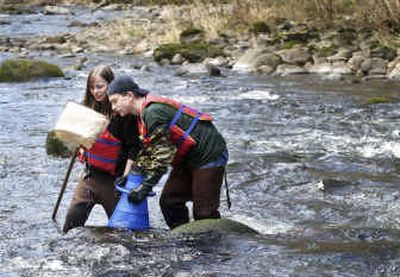Creating a welcome environment

SALEM, Ore. — Kelly McGrath, 25, moved to Oregon from Ohio for the things that make the state special: mountains and coastline, salmon and deer, dripping moss and towering trees.
“I dove headfirst (into the outdoors),” she said. “I moved here for the mountains and the coast.” And now, she spends most of her time rock climbing, backpacking and mountain biking.
More Pacific Coast residents spend their time hiking, backpacking, visiting nature centers and sightseeing than in any other region in the country, according to a U.S. Forest Service recreation survey conducted 10 years ago. More also visit beaches, study nature, sail and kayak.
But teenagers and minorities are often not in the mix.
The Willamette National Forest recorded nearly 1.6 million visits in 2000. Most were older than 50, and almost 31 percent of the visitors were between 21 and 40.
In the same year, 95.4 percent of visitors to the forest were white. Only 1 percent were Spanish, Hispanic or Latino. And only 0.1 percent were black.
Public-land managers in Oregon and elsewhere are trying to increase the numbers of young and diverse users. Yellow school buses frequently are seen at trailheads and visitor centers. Programs for urban schools — with higher minority populations — are popular among land managers.
“Oregon is a green state, and people like the outdoors,” said Al Matecko, director of public and legislative affairs for the U.S. Forest Service’s Pacific Northwest region. “We’ve tried to work with school groups — K through 12 — to talk about what the forest is and encourage recreation, like camping, fishing and hiking. And we reach out to people of color.”
The Siuslaw National Forest gets 2 million visitors per year and recently has seen an increase of 1 percent to 2 percent of visitors each year.
“If you can get young people to develop an appreciation for wild lands, they will continue to do that as they age,” said Mike Harvey, acting recreation staff officer at the Siuslaw forest.
But, in this age of technological advances, that is not always easy.
“I think there are more things to occupy young people’s time and energy maybe than there was in the past,” Harvey said. “Visits to the national forest is just one of a lot of choices people have to decide among.”
These students are exposed to public lands much more than their counterparts in other schools. Even so, many don’t spend much of their free time on public lands — some because of transportation issues, others because they already spend so much time outside in school, and still others because of technology.
“I think a lot of it has to do with televisions and a sedentary lifestyle,” said instructor Jen Scherzinger, 25, of Portland. “And kids are bored by observation in nature. People who are older just go out to look. In a city, there is so much stimulation.”
Scherzinger said that urban young people are often stuck in a concrete environment.
“Being in the city, people are very removed from the natural environment,” she said. “They don’t know where their drinking water comes from.”
Tyson Jeffries, 15, has grown up hunting and fishing, mostly because his family has a cabin on the Deschutes River. However, his peers don’t have similar experiences.
“My friends skateboard mostly,” he said.
Lisa Wheeler, 15, said she would go hiking and camping more if she had a car and her parents would let her go out just with her friends. But she wasn’t always so interested in the outdoors.
“A couple of years ago, I used to come home from school and just watch TV,” she said. “It actually started to make me depressed.”
Johnny Woodruff, 16, said he has a Sony PlayStation for video games but hasn’t used it in more than a year. He said he would much rather be hunting, fishing, camping or hiking than be inside watching television or playing video games.
“Hiking up a mountain is much more of an accomplishment that conquering a video game,” he said.